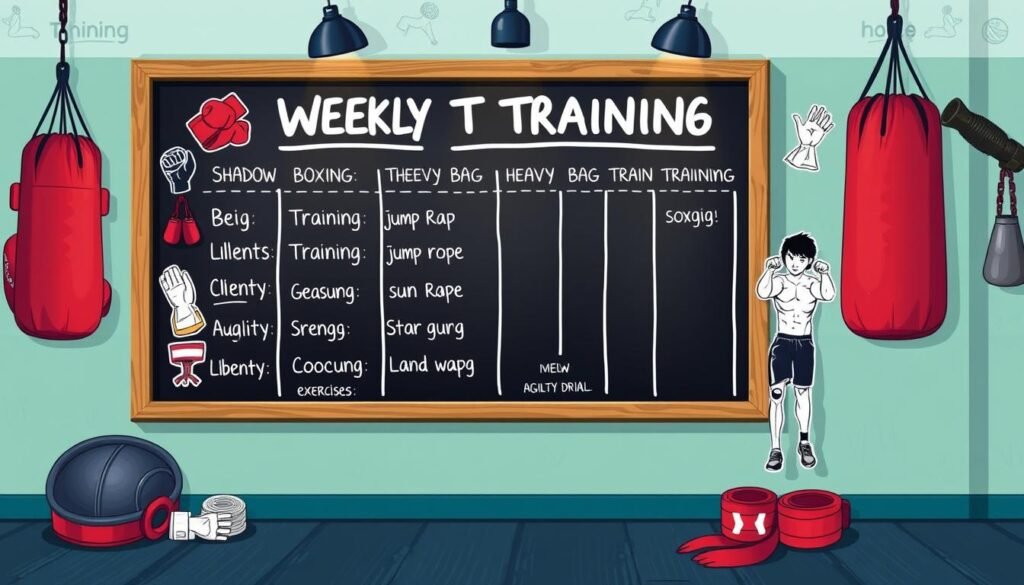To build muscle like a boxer, it’s more than just fighting in a ring. It means living a lifestyle that blends top-notch athletic training with a strict routine. A workout for fighters aims to create a strong, agile, and slim body. It focuses on strength and quickness. Besides following a precise boxing workout, eating right is crucial. This diet helps support the intense lifestyle of a fighter.
To get in shape like a boxer, balancing different types of exercises and diet is key. You need to do lots of cardio, strength exercises that work many joints, and eat lots of veggies. This mix keeps your muscles fueled and ready to repair after your workouts.
The Foundation of a Boxer Physique: Cardio and Resistance Training
Key Takeaways
- A thorough blending of cardio and resistance training is key to crafting a boxer’s lean and muscular form.
- Performing compound exercises such as squats and bench presses is essential for building mass and strength.
- An intelligently crafted diet rich in proteins and low in unhealthy fats is central for weight management and muscle recovery.
- To sustain the physical demands of boxing, incorporating HIIT along with steady-state cardio ensures top-notch cardiovascular health.
- Setting aside time for proper rest and recovery, including adequate sleep, is indispensable for peak performance and health.
- Being disciplined with a six-day training regimen can maximize fitness gains and enhance skill proficiency.
- Exercises targeting core strength, agility, and explosive power are pivotal for a boxer’s performance in the ring.
The Foundation of a Boxer Physique: Cardio and Resistance Training
To get a boxer physique, mixing cardio and resistance training is key. It’s not just for looks; it’s for building the strength and stamina boxers need. This kind of training makes them fit and ready for their sport.
Cardio is essential for staying power and losing fat. Running 2 to 5 miles three times a week builds endurance. Jumping rope is also crucial. It heats the body up, betters footwork, and links the mind and movements. Each session has four rounds, like a real fight.
In strength and conditioning, resistance training uses different moves to make muscles strong. Exercises like pushups, pull-ups, and squats aim for 100 reps to test your limits. Shadow boxing with light weights adds a layer by mixing strength with technique. It mimics fighting but with extra weight.
The essence of strength and conditioning for a boxer’s training is shown below. This table covers the main parts of a boxer’s routine:
| Activity | Description | Rounds/Reps |
|---|---|---|
| Road Work (Running) | Build endurance and cardiovascular capacity | 2-5 miles, 3x weekly |
| Jumping Rope | Improve coordination and footwork | 4 rounds |
| Shadow Boxing with Weights | Enhance punching technique and upper body strength | 300 punches with incremental weight |
| Heavy Bag | Practice punches with full arm extension | Varies per session |
| Calisthenics | Strengthen muscles and increase muscle endurance | 100 reps per exercise |
| Sparring | Strategy application and combat practice | Scenario-based drills |
This combination helps athletes become strong enough to compete. It gives them a training plan that helps them stay healthy and do well in the sport. These steps are crucial for anyone wanting the strength and conditioning for a boxer’s body.
Building Muscle Like a Fighter: Key Resistance Exercises
Want to build muscle like a boxer? Focus on resistance training designed for boxers. This training boosts your strength and agility, key for boxing. Let’s explore the main resistance workouts for your training plan.
Squats and Deadlifts
Squats and deadlifts are essential for a powerful lower body and core. They work many muscles, crucial for boxing strength. Squats increase your lower body power, helping you move quickly and hit hard. Deadlifts, especially the Trap Bar kind, focus on often ignored muscles in boxing, keeping your back safe.
Bench Press and Rows
For upper body power, bench press and rows are perfect. They strengthen muscles important for faster and harder punches. Upper body power, when combined with strong legs, makes for effective boxing. Try incline bench press to target muscles more precisely.
Calisthenics for Functional Strength
Calisthenics is vital for boxers’ resistance training. Push-ups, pull-ups, and planks boost muscle endurance and core stability. These exercises are key for the functional strength needed in boxing.
Planning these exercises around your boxing training phases is smart. Here’s a quick overview of exercises, along with sets, reps, and rest times:
| Phase | Exercise | Sets and Reps | Rest Between Sets |
|---|---|---|---|
| General Preparation | Squats, Pull-ups | 5 sets of 6 reps | 3-5 minutes |
| Strength and Power | Romanian Deadlift, Incline Bench Press | 5 sets of 6 reps | 3-5 minutes |
| Speed and Agility | Broad Jumps, Agility Ladder | 5 sets of 30 seconds | 1-2 minutes |
| Maintenance of Strength | Hang Clean, Crunches | 3 sets of 10 reps | 1-2 minutes |
Sticking to a workout plan makes building muscle more effective. For extra tips and privacy info, visit this resource.
The Boxer’s Diet: Fuel for a Lean and Powerful Physique
To keep up a boxer physique, eating right is key. A diet rich in proteins aids muscle repair and helps maintain muscle needed by boxers. It’s crucial to balance macronutrients to support tough training and improve performance.
What a boxer eats is vital. Half their plate should be fruits and veggies for key vitamins and minerals. One-fourth ought to be whole grains for sustained energy. The last quarter should be proteins for repairing and building muscle.
- Staying hydrated is vital, with at least eight cups of water a day to help the body and training.
- Eating foods like fruits, nuts, and granola bars before a fight provides quick energy.
- After working out, a mix of proteins and carbs is essential to rebuild energy stores and help muscles recover.
Boxers should avoid added sugars, processed snacks, and alcohol to ensure their diet is effective. Embracing local dishes and personal favorites, such as Anthony Joshua’s choice of Nigerian dishes like pounded yam and egusi, is also key. It helps with sticking to their diet plan.
The importance of a high protein diet and timing meals right is huge for a boxer. Eating foods like salmon, which has omega-3s, and oats for breakfast is crucial. They are good for heart health and provide constant energy, helping maintain a boxer’s physique.
Eating well for nutrition for fighters means more than just specific foods. It’s about a balanced diet that meets the extreme physical demands of boxing. This supports overall health and boosts performance.
Essential Cardio for Boxing: From Steady-State to HIIT
Cardio for boxers is more than just endurance. It sets the stage for every battle in the ring. Combining steady-state cardio with high-intensity interval training (HIIT) boosts a boxer’s performance. It improves their aerobic power, stamina, and explosive strength.
Implementing Steady-State Cardio
Steady-state cardio includes activities like jogging or cycling at a constant pace. It’s key for building a boxer’s endurance. It helps them keep up their energy over long periods. To keep their aerobic base solid, boxers should do these exercises for 30-60 minutes, 3-4 times a week in the off-season.
Integrating High-Intensity Interval Training
HIIT is key for boxers too. It’s short, intense activity bursts followed by rest. Sprint intervals and circuit training boost aerobic and anaerobic fitness. For example, a boxer might do 30-second full-effort sprints, then rest for 30 seconds. This approach quickly improves fitness, oxidative enzyme capacity, and coordination.

| Cardio Type | Description | Frequency | Benefits |
|---|---|---|---|
| Steady-State Cardio | Long duration activities at a consistent speed | 3-4 times weekly (off-season) | Builds endurance, improves cardiovascular health |
| High-Intensity Interval Training (HIIT) | Short, intense bursts of activity followed by rest | 2-3 times weekly | Enhances aerobic and anaerobic capacity, burns fat efficiently |
By wisely combining steady-state cardio and HIIT, boxers become fight-ready. They are prepared for the tough demands of each round with lasting stamina and toughness.
The Role of Sleep and Recovery in Training
For boxers, both recovery and training rely a lot on sleep strategies. Their intense routines need more than just being fit. They also require a strong recovery plan. This helps them stay ready for battles and keep up their performance in the long run.
Experts say boxers should get 10 to 13 hours of sleep a night. This helps restore energy and fixes muscles. Such a long sleep is key because it’s when the body heals itself.
Good sleep boosts melatonin during deep sleep. This helps keep the sleep cycle regular and improves sleep quality. These processes are key. They help muscles heal and refresh after workouts.
- Enhanced cognitive functions: Enough sleep sharpens memory, focus, and decision-making. These are crucial for a boxer’s success both inside and outside the ring.
- Injury recovery: Sleep helps heal injuries by releasing healing hormones. This speeds up tissue repair and lowers swelling.
- Optimized mood and motivation: Regular sleep patterns help keep emotions stable and increase drive. Both are vital for facing hard training sessions and contests.
Making a perfect sleep environment is key for best recovery. Boxers should have a dark, quiet place to sleep that’s at a nice temperature. They should also avoid caffeine and cut down on screen time before bed to sleep better.
In professional sports, like boxing, using the right recovery methods is as important as physical training. Boxers must see recovery, especially sleep, as a main part of their training. It’s what keeps their performance up and their health at its best.
Weekly Training Breakdown for Achieving a Boxer Physique
To get a boxer’s body, you need a special boxer training regimen. It mixes strength, quickness, and stamina exercises. Here’s a comprehensive weekly workout routine for those wanting a fighter’s build.

The plan aims to boost a boxer’s fitness through cardio, weights, and boxing drills. Monday starts with workouts for fighters, preparing you for the week’s challenges.
| Day | Activities | Focus Area |
|---|---|---|
| Monday | Long distance running (3-5 miles), footwork drills, light shadow boxing | Endurance & Technique |
| Tuesday | Gym: Resistance training (heavy lifts, ground work exercises), heavy bag rounds | Strength & Power |
| Wednesday | Rest & Recovery | Rest |
| Thursday | Interval running, mitt work with coach, film study | Speed & Reflexes |
| Friday | Gym: Weight training (focused on mid-range reps), shadow boxing | Muscle Building |
| Saturday | Match training, heavy bag drills, functional strength workouts | Combat Preparedness |
| Sunday | Active rest (light jogging or stretching) | Recovery & Flexibility |
Diet is vital, with carbs, lean proteins, and healthy fats needed for energy and muscle healing. Eating right and staying hydrated are key to keeping your energy up.
In summary, this weekly plan is about more than just workouts. It covers strength, know-how, and mental prep—everything a boxer needs. It’s a clear route to top physical and mental shape for fighters at all levels.
Optimize Your Workouts with the BoxRope Vol.1.
If you love boxing and want to get better, choosing the right workout equipment is key. The BoxRope Vol.1 is a top pick for boxers. It’s a optimized jump rope for boxing designed just for a boxer’s needs.
This isn’t your everyday jump rope. It’s made with top-notch quality, being about 15% heavier than others. This helps build stronger arms and last longer in the ring. Plus, it’s 20% tighter, making you faster and more in control in your workouts.
- Increased Metabolic Rate: Its weight helps you burn more calories and lose fat faster.
- Enhanced Coordination: Using this workout equipment often improves your footwork and timing, key skills in boxing.
- Superior Flexibility: Its flexible design lets you move more, perfecting those tricky boxing combos.
Looking to boost your workout game? Try mixing this tool into your routine with a 20 minute boxing workout. It shows how such gear can make training sessions better.
The BoxRope Vol.1 is praised by both pros and beginners. It’s not just any rope, but a vital piece of a boxer’s workout equipment. It boosts both your body and mind, making it a must-have for serious boxing fans.
The Mental and Physical Benefits of a Boxing Workout
Starting a boxing workout helps your mind and body in many ways. It helps you become tough mentally and stay in shape physically. Boxing makes you focus your energy, boost your brain power, and build your inner strength. A study with college students showed boxing lessens depression, anxiety, and stress symptoms. It shows how exercise can make you feel mentally better.
Boxing workouts have structure, much like life does. They mix intense effort and rest. This helps improve focus and brain function, giving you better concentration and alertness. Boxing is also great for relieving stress. It allows you to let out aggression and tension in a healthy way. This can help manage anger and make you feel happier. The physical gains are big too, boosting heart health, balance, and muscle strength.
Boxing helps you feel more confident, especially by teaching self-defense. This makes you feel safer in and out of the gym. It also increases happiness and focus, similar to meditation. Following the U.S. Department of Health and Human Services’ advice, adding boxing to your week is good for your heart. It helps beat the risks of sitting too much. Boxing is more than fighting; it trains your body and mind for a healthier, stronger you.

